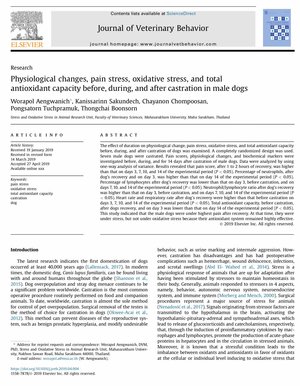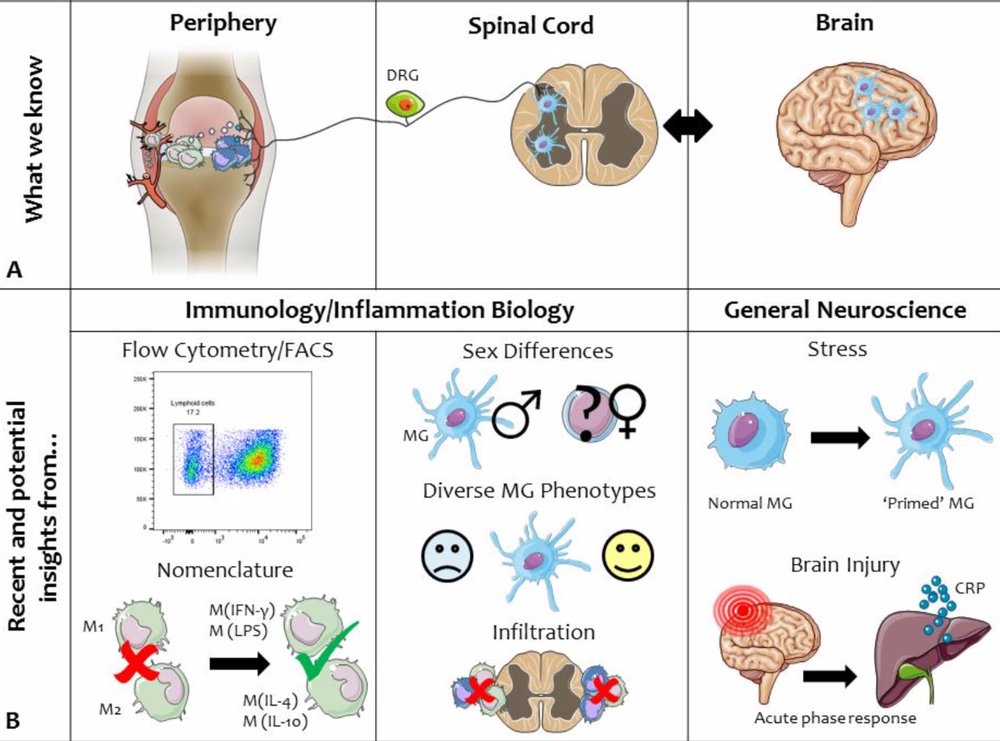Sténose LOMBO-SACRÉE – Castration chien – Douleur chronique et immunité
DOULEUR CHEZ LES CHIENS ET CHATS
1/ Clinical findings in degenerative lumbosacral stenosis (DLSS) in ten dogs – a pilot study on the analgesic activity of tramadol and gabapentin
Elisabetta Giudice, Chiara Crinò, Giuseppe Barillaro, Rosalia Crupi, Simona Di Pietro J. Vet. Behav., In Press, Accepted Manuscript, Available online 23 May 2019
Résumé :
Degenerative lumbosacral stenosis (DLSS) is a relatively common multifactorial disease which affects mainly large breed or working dogs. It can cause neuropathic pain, and advanced imaging techniques are essential to achieve a final diagnosis. For improving the quality of life, when surgery is not possible, a conservative treatment is necessary. The management of pain requires early intervention and evaluation of response on an individual-patient basis. The aim of the study was to evaluate the use of tramadol for the treatment of lumbosacral pain in dogs affected by DLSS diagnosed by radiographs, computed tomography (CT) and CT myelography, considering gabapentin as an alternative treatment in case of unresponsiveness. Ten dogs were enrolled, and clinical findings and their severity scores were recorded; the short form of the Glasgow composite pain scale (GCPS-SF) was used to assess pain scores before (8.6±1.5; 7-11/20) and during treatment (after 1, 2 and 4 weeks) with oral tramadol (3 mg/Kg every 8 hours) and prednisolone (0.5 mg/Kg/die) for 4 weeks. After the first week of therapy, only half of the dogs (5/10, T-group) showed a significant improvement of GCPS-FS score; in the remaining five dogs (G-group) tramadol was changed with oral gabapentin (10 mg/Kg every 8 hours for 3 weeks), with an improvement in pain score in one week. At the end of treatment, all the dogs showed low pain scores (T-group: 2.8±0.8; G-group: 1.6±0.9), below the intervention level (4/20). Given the supported evidence, oral tramadol should not be relied on as a sole or first-line analgesic in dogs, and gabapentin might be a valid alternative option in an outpatient setting. As controlled clinical trials are still lacking in animals, further studies should be carried out in order to confirm the analgesic activity of gabapentin in veterinary painful conditions and to rule out eventual adverse effects related to a prolonged administration.
PDF : https://www.capdouleur.fr/app/uploads/2019/07/giudice2019.pdf
2/ Physiological Changes, Pain Stress, Oxidative Stress and Total Antioxidant Capacity Before, During, and After Castration in Male Dogs
Worapol Aengwanich, Kanissarinn Sakundech, Chayanon Chompoosan, Pongsatorn Tuchpramuk, Thongchai Boonsorn J. Vet. Behav., In Press, Accepted Manuscript, Available online 6 May 2019
Résumé :
The effect of duration on physiological change, pain stress, oxidative stress and total antioxidant capacity before, during, and after castration of dogs was examined. A completely randomized design was used. Seven male dogs were castrated. Pain scores, physiological changes and biochemical markers were investigated before, during, and for 14 days after castration of male dogs. Data were analyzed by using one-way analysis of variance. Results revealed that pain score, after 1 to 2 hours of recovery, was higher than on days 3, 7, 10 and 14 of the experimental period (P<0.05). Percentage of neutrophils, after dog’s recovery and on day 3, was higher than on day 14 of the experimental period (P<0.05). Percentage of lymphocytes after dog’s recovery was lower than on day 3, prior to castration, and on days 7, 10 and 14 of the experimental period (P<0.05). Neutrophil/lymphocyte ratio after dog’s recovery was higher than on day 3, prior to castration, and on days 7, 10 and 14 of the experimental period (P<0.05). Heart rate and respiratory rate after dog’s recovery were higher than prior to castration on days 3, 7, 10 and 14 of the experimental period (P<0.05). Total antioxidant capacity, prior to castration, after dogs recovery, and on day 3 was lower than on day 14 of the experimental period (P<0.05). This study indicated that the male dogs were under highest pain after recovery. At that time, they were under stress, but not under oxidative stress because their antioxidant system remained highly effective.

3/ Neuroimmune interactions in chronic pain – an interdisciplinary perspective
Zoe Hore, Franziska Denk Brain, Behav. Immun., In Press, Accepted Manuscript, Available online 25 April 2019
Résumé :
It is widely accepted that communication between the nervous and immune systems is involved in the development of chronic pain. At each level of the nervous system, immune cells have been reported to accompany and frequently mediate dysfunction of nociceptive circuitry; however the exact mechanisms are not fully understood. One way to speed up progress in this area is to increase interdisciplinary cross-talk. This review sets out to summarize what pain research has already learnt, or indeed might still learn, from examining peripheral and central nociceptive mechanisms using tools and perspectives from other fields like immunology, inflammation biology or the study of stress.





